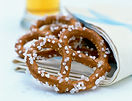top of page

FROM THE GROWERS - Sweet & Savory






sweet treats
HONEY
NATIONAL HONEY BOARD
Get the BUZZ on all things honey - a slew of recipes are available, as well as how bees create honey (a brochure for kids simplifies the process, which is helpful for adults, too), the myriad of varietals available (depends on which floral source the bees are pollinating), honey suppliers by state, and the latest in honey and bee research.
Holidays: September is National Honey Month.
sugar
THE SUGAR ASSOCIATION
Here are the facts: Sugar is naturally derived from the plants sugar beets and sugar cane. Each teaspoon contains 15 calories. Sugar is a carbohydrate (also found in vegetables, fruits and grains) - though processed sugar is a simple carb, while foods such as whole grains are complex carbs (the body works harder to breakdown starch and fiber). Sugar from fruit and processed sugar is composed of fructose and glucose (though the percentage varies in fruit, and sugar is 50/50). The average 12 oz. can of soda (regular, not diet) contains about 10 teaspoons of sugar (or the equivalent of High Fructose Corn Syrup, derived from corn). Read food labels to see how much sugar is in your food. Learn more about sugar on their website and how sugar can be a part of a balanced diet. The key is understanding what it means to be balanced - that's the sweet spot. The Sugar Association does not readily address the potential health harm caused by eating too much sugar.
SUGARSCIENCE.ORG
From their website: "Designed as an authoritative source for the scientific evidence about sugar and its impact on health. Developed by a team of health scientists from the University of California, San Francisco (UCSF), the site reflects an exhaustive review of more than 8,000 scientific papers that have been published to date, with a focus on the areas where the science is strongest – specifically, on diabetes, heart disease and liver disease." A different view than that of The Sugar Association.
candy & CHOCOLATE
NATIONAL CONFECTIONERS ASSOCIATION
...
ICE CREAM
I scream, you scream, we all scream for....1.54 billion gallons of ice cream (and related frozen desserts) in the U.S. in 2015, according to the IDFA (International Dairy Foods Assoc.). Ice cream probably originated in Italy or France in the late 1600s, with an earlier version akin to sorbet invented earlier, perhaps in China. Read a brief history of ice cream - learn how we got from ice and snow flavored with honey to the modern product we love, and celebrate the holidays. Better yet, have some in the freezer for an after dinner dessert treat. Just remember - save some for tomorrow!
History: PBS IDFA CW
Holidays:
National Ice Cream Month is July
National Ice Cream Day is the Third Sunday in July
National Ice Cream Cone Day is September 22
sALTY
SALT
SALT INSTITUTE
In April 2019, the Salt Institute, which advocated for salt's benefits as well as healthy eating, closed their doors (or dissolved, as one clever headline read.) While the debate continues about how much salt (sodium chloride) is too much in our diet (general guidelines are between 1500mg and 2200mg per day) there is no debate that salt makes our food taste great, keeps our roads safer in winter, and is useful in water softening. So grab a snack, salty or otherwise, and start shaking! Types of salt? Too much salt? Pass the salt or pass on the salt - you decide. Read these links: Whole Foods | SaltWorks | Morton | CDC (Centers for Disease Conrol & Prevention)
savory
A spice is something In general, herbs are the leaves of plants, whereas spices are the crushed seeds, roots and bark (i.e. cinnamon) of plants. So we can say that all herbs are spices, but not all spices are herbs...now it's clear!
flavoring
DIFFERENCE BETWEEN NATURAL AND ARTIFICIAL FLAVORS...
How natural is natural - and is there a difference between the two - are natural flavors any healthier than artificial flavors? Yes, but not by much. Natural flavors are still processed. Learn more from this NPR article.
oils
NORTH AMERICA OLIVE OIL ASSOCIATION
...
spices
MCCCORMICK SPICE INSTITUTE
...
herbs
THE HERB SOCIETY OF AMERICA
...
MINT INDUSTRY RESEARCH COUNCIL
...
IDAHO MINT COMMISSION
...
bottom of page


